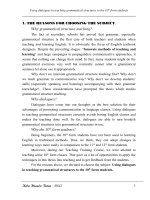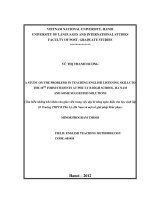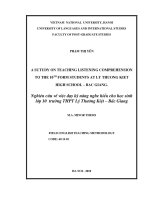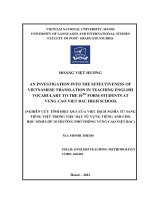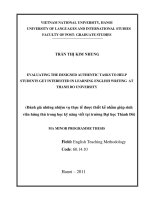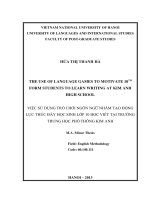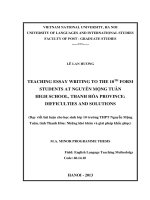Some techniques to help 10th form students diminish reticence in learning english speaking skill” ( new english textbook)
Bạn đang xem bản rút gọn của tài liệu. Xem và tải ngay bản đầy đủ của tài liệu tại đây (1.63 MB, 31 trang )
I. INTRODUCTION
1. Reasons for choosing the topic:
It is undeniable that English is an international language and together with its
increasing importance, the need of learning English is becoming more urgent than
ever.
In learning English at high schools in Vietnam, speaking skill has become
compulsory since the old English textbook was put into use in 2006, and it is
especially attached the great importance in NEW English textbook ( published in
2012).
However, as we can see, for a long time, the language teaching and learning have
been based on the out-of-date methods in which students only passively sit, take
notes but rarely contribute to the lessons. They do not ask their teacher questions,
even when they have problems. Therefore, when approaching new teaching
methods such as Communicative Language Teaching (CLT) and Project- based
approach, students feel passive in classroom. This results in numerous problems
inflicting students in learning the speaking skill, one of which is the reticence in
oral activities.
There have been a variety of studies on this situation and various solutions
have been given. However, students’ reticence is still common occurrence in
language
classrooms
in
Vietnam. Based
on
my
twelve-year
teaching
experience at Hoang Hoa 4 high school, I know that the students rarely speak
English, even in English speaking classes, though they have been learning English
since they were at the primary school.
It is important to involve students in classroom learning activities and minimize
their reticence because involvement in classroom interaction will help students
explore and learn English much better.
For such reasons I choose “ Some techniques to help 10 th- form students diminish
reticence in learning English speaking skill” ( New English textbook) as a theme
for my experiential initiative.
2. Aims of the study: The study is carried out to:
(1 ) Find out some factors causing 10 th- form students to be reticent in English
speaking activities.
1
(2 ) Give some suggestions to stimulate students to speak English.
3. Scope of the study:
The subjects chosen for this study are 10th- form students at Hoang Hoa 4
high school, Thanh Hoa province where I have been teaching. Moreover,
because of the limited time and within an experiential initiative, only speaking skill
was chosen on the ground that speaking seems to be the most challenging language
skill to English learners in Vietnam in general.
4. Methods of the study:
To achieve the objectives of the study, several methods are used, but I use
mainly quantitative and qualitative methods.
The data serving the research analysis and discussions are collected by means of a
survey questionnaire for students and observation.
5. New things of the study:
The study is based on what I did research in the school year 2013-2014, but in
this research, the scope of the study is the students who are learning New English
Textbook.
II. DEVELOPMENT
1. THEORETICAL BACKGROUND:
1.1. Definition of reticence:
Reticence is generally viewed as an abstract concept and has been defined
by many researchers. McCroskey (1977) portraits it as “an individual’s level of
fear or anxiety associated with either real or anticipated communication with
another person or persons ”. Reticent people often speak less and for shorter
durations; their language tends to be less comprehensible, less immediate, and
less intense (Evans, 1996).
A student’s reticence in class not only reveals that he/she is unwilling to talk
in certain circumstances; it could also indicate any of the following symptoms:
(1) the student’s apathy toward the topic at hand or to the learning process itself;
(2) the student who is not comprehending is overwhelmed, or is bored;
(3) the student is isolated from the learning community;
(4) the student has not learned the value or strategies of engagement or he/she does
not appreciate or believe in that value.
2
It can be seen that different researchers approach reticence’s definitions in different
ways. However, they all share the same point of view that reticence is quite
pervasive
in English as a second language (ESL) and English as a foreign
language (EFL) classrooms and can negatively affect the learning of the
target language.
1.2. Possible causes of language learning reticence:
In the past few decades, an increasing number of studies in ESL/EFL have been
conducted to explore the reasons for students’ reticence in classrooms. Generally
speaking, reticence in class discussions might result from:
(1) low self esteem – students who think of themselves as unworthy or unable to
communicate successfully, so they tend to remain silent out of shame.
(2) fear of being ridiculed when they inappropriately or inaccurately respond.
(3) fear of success – this occurs when a student interacts successfully; they
attributes their success to luck or accident and then is apprehensive for others
expecting him/herself to continue excellent performance, which means to interact
with similar or superior success in the future.
(4) cultural differences – various cultures forbid or strongly discourage individuals
from speaking up in classroom settings; sometimes for the reason of deference
towards teachers; elder students’ behaviour could also contribute to this
phenomenon.
(5) communication apprehension – a clinical fear of communicating with or
in the presence of others.
1.3. Effects of reticence in class:
The effects of reticence are particularly evident in ESL/ EFL classes and it,
to some degree, is a strong indicator of academic performance. Reticence
negatively affects everything from the teachers’ expectations of
student
performance, actual classroom performance, and perceptions of others while
communicating.
Reticent learners suffer from mental blocks during spontaneous speaking
activities, lack confidence, are less able to self-edit and identify language errors
and are more likely to employ strategies such as skipping class. Reticent students
also forget previously learned material, volunteer answers less frequently and have
3
a greater tendency to remain passive in classroom activities than their less reticent
counterparts.
The effects of reticence could also extend outside the second language
classroom. A high level of reticence might also correspond with communication
apprehension, causing individuals to be quieter and less willing to communicate in
other
public occasions. As
a result,
people who
exhibit this
kind
of
communication reticence are more likely to be perceived as less trustworthy, less
competent, less socially and physically attractive, tenser, less composed and
less dominant.
Therefore, working on reticence problem in and out of class is of great
significance not only in academic development, but also in mental development of
the students.
2. FACTUAL BACKGROUND:
2.1. Research setting:
The study was conducted at Hoang Hoa 4 high school, a rural school of Thanh Hoa
province. The school was established in 1989 and it has recorded a lot of
achievements in training provincial gifted students for some recent years.
The school has 32 classes with over 70 teachers of different subjects. Each
class consists of about 40 students. Most of the students come from the villages in
the district where English learning and teaching does not get much attention. The
only sources from which students can get knowledge are the textbooks and their
teachers. Like students in many other schools in Vietnam, students in my school
are complained a great deal for their inability to use English for communication
after leaving school.
The total number of English teachers at Hoang Hoa 4 high school is 7. All of
them are female aged from 30 to 42. They were trained from training courses in
English language teaching at different universities in Vietnam. All of them are
friendly, active, knowledgeable and full of inspiration for teaching.
The main English textbooks used in teaching English at this school are Tieng
Anh 10, Tieng Anh 11, and Tieng Anh 12 ( Basic stream). Besides, in the school
year 2017-2018, there is one 11th- grade class ( 11A10) and two 10th- grade classes
(10A4 and 10A10) applying NEW ENGLISH TEXTBOOK
4
( published in 2012). The teaching method applied by the teachers at this school is
various and integrated, but mainly Grammar Translation Method (GTM) because
both teachers and students are more concerned about the students’ performance in
the national examination for 12th students and the examination for gifted students.
Therefore, from my personal observation as a classroom teacher, students are
unwilling to speak English in the speaking lessons.
The teaching of English in general and the teaching of English speaking in
particular at my school has encountered many difficulties. As a consequence, it is
very necessary for the staff at Hoang Hoa 4 high school to find out effective ways
to minimize the difficulties in teaching English and from then, to improve the
quality of English speaking lessons.
2.2. Major findings: Factors making 10th- form students at Hoang Hoa 4 high
school reticent in English speaking lessons.
The study showed that the level of students’ participation in speaking activities was
very low. A lot of students tended to be reticent in the speaking lessons. With
regard to what contributed to students’ reticence in classroom, many factors were
identified. They were students’ factors, teacher’s factors and objective factors.
Firstly, a range of student- related factors brought reticence into play.
Among these factors, the most prominent one was low English proficiency.
Although all of the students had learnt English for at least 7 years, their English
language proficiency such as vocabulary, grammar, even pronunciation was poor.
Gradually, they would not feel interested in speaking and became reticent.
Another important factor was the fear of being laughed at when making mistakes.
Probably because of the fear of leaving a bad impression on the teacher and
peers, many students worried about making mistakes and thus, were unwilling
to speak.
Addition to it was “personality”. Some students were so shy and introverted
that they became nervous when speaking to a group of people even in the
mother tongue, let alone the foreign language.
Another factor was “ Students’ speaking skill is influenced by their mothertongue”. During my reality of teaching, I realize that students are greatly affected
by their mother-tongue while speaking. When being required to talk about a given
5
topic, it is common that students first think about the ideas in Vietnamese, then try
to translate them into English. This has been proved ineffective in developing
students’ speaking ability. It is much better that students are guided to think in
English in order to make their speaking more natural.
Secondly, the findings referred to teacher’s factors. According to the
questionnaire for students, the most important factor relating to teachers was
teachers’ ways of mistake correction. In speaking lessons at Hoang Hoa 4 high
school, students were often interfered immediately when they made mistakes
during their performances. This was a great influence on their continuous speaking.
Too much teacher’s talking time was the factor 52% of the students chose. The
teachers occupied almost all the class time, so students didn’t have much time to
speak. Therefore, chances given to them to express their own ideas were limited. In
stead of taking part in oral activities actively, they only kept silent, took notes
and spoke only when they were asked to.
One more factor was teacher’s uneven allocation of turns. 42% complained their
teacher favored the better students when soliciting responses. That was the reason
why some lower proficient students in class had few chances to speak out.
Another reason was some teacher’s preference for using Vietnamese in English
lessons.
Last but not least, it was Teachers’ assistance does not meet students’ needs: Some
students sometimes don’t know how totalk about a given topic due to their
teacher’s unclear instructions or vague explanations, for example. Besides, the
inappropriate method of their teachers discourages them. Consequently, the
teachers works as a controller while the students become passive.
Thirdly, objective factors like large and multilevel classes, time constraint
and text book also resulted in the students’ silence in speaking lessons.
While speaking topics in the textbook were interesting, the difficulty of speaking
tasks was one of the factors that caused to the students’ silence in oral activities.
Another factor is full- sized classes. With the average number of students was 40 to
49 in each class with different ability, it was not easy for teachers to control their
students’ activities. Consequently, many students kept silent all the time. Besides,
6
lack of time was a factor, though it only took up a small percentage. The teacher is
always under pressure to cover the allocated syllabus in the time allowed. Due to
time limit, learners had little chance to practice in class. The teachers seldom asked
students to do pair work or group work, and classroom interaction was usually in
the form of short questions and answers.
3. IMPLEMENTATION AND SOLUTIONS:
From the major findings of the study, in order to minimize the students’
reticence in English speaking lessons, some suggestions have been made with the
hope to improve the current situation of teaching and learning the speaking skill.
3.1. Increasing students’ English proficiency:
As can be viewed from the survey questionnaire for students, low English
proficiency was the greatest contributor to the students’ reticence in oral English
lessons. Thus, it is very essential for teachers to find solutions to enhance students’
English competence.
If students lack words or structures to express themselves, what teachers
should do is providing structures and related words when introducing topics
through listening or reading as pre-speaking activities. Teachers should provide
examples which are great helping enrich their vocabulary, memorizing phonetic
sounds and stress as well as grammatical structures. Besides, teachers should pay
attention to students when they are speaking so as to guess their ideas to support
them in case they cannot find exact words to express themselves. What is more,
teachers need to explain that words represent thoughts so students should not
attempt to use unusual syntax, or “big words” but try to find direct and meaningful
ways of making them understood.
For example, when teaching Activity 3 - Speaking- Unit 4: For a better
community- Tiếng Anh 10 tập 2.
The aim of this task is that students will be able to talk about the three most
important things to do in your local area.
I provide students with useful phrases:
- The most important thing to do is…………… now that……..
- The second priority is…………………..on the ground that…….
- We consider …………….. to be the priority because……..
7
If students have difficulties in finding ideas for the topics, teachers can make
use of and introduce various ideas for discussion to make these topics interesting
and familiar enough to students. This problem can also be solved by choosing the
topics which are more interesting and appropriate to the students’ age, level, and
relating to the real life to create enjoyable class atmosphere that make reluctant
students interested in speaking.
For example, when teaching Activity 4- Speaking- Unit 9: Preserving the
environment- Tiếng Anh 10 tập 2.
The aim of this task is that students will be able to talk about the environmental
impacts of human activities.
Procedure:
- Give suggestions and ask students to complete the table:
Human activity
Type of
Consequence
pollution
fossil fuel burning by
motor vehicles,
factories, aircrafts and
a
problems
air pollution
rubbish and chemicals
of
such
environmental
as
acid
rain,
greenhouse effect, globe warming
rockets
fertilizers and pesticide
sprays, harmful
series
and health problem
contaminated vegetation and the
decrease of soil fertility leading to
soil pollution
the negative utilization of land
thrown in the rivers
loud and annoying
human psychological and health
sounds from factory
problems such as stress, the
machinery, motor
noise pollution
vehicles, aircraft, and
increase of health rate and hearing
damage
musical instruments
- Ask students to complete the conversation:
Sample:
Student A: Our earth is having the severe soil pollution. The soil is very harmful
now.
8
Student B: Yes, It is the result of human activities. People use fertilizer and spray
pesticides, threw harmful rubbish and chemicals in the river.
Student A: These cause the vegetation contaminated and the the decrease of soil
fertility. This leads the negative unilization of land.
- Call two or three pairs to present and then give feedback.
3.2. Creating a friendly classroom atmosphere and rapport with students :
The relationship that the teacher build with their students influences the
interaction that takes place in the classroom. Research has shown that students are
more willing to speak in class when the teachers make the class environment one
of interest and engagement, which will then lessen learner reticence. Besides, as
recommended by the student interviewees, teachers have to develop positive
personality traits such as patience, a sense of humor, or considerateness
to make students more comfortable with their language learning process.
During the teaching process, I always try to remember the students’ name and
then use their names. Instead of pointing at students and asking: “ What is your
opinion about.......?”, I often say: “ Hoa, Could you tell me something about this
matter?”. I assume that when students are called by their names, they will feel
happier because their teacher shows his/ her concern to them.
Walking around the classroom and assisting the learners when necessary
during the lessons is an useful way I apply to bring the friendly. Furthermore, I also
give students immediate praise, compliment and encouragement than criticism.
For example, after the student’s presentation, I often use encouraging words such
as : "Good ideas", "Excellent" , "Perfect", "Well done”. Furthermore, smiling
expectantly, nodding as students talk and maintaining eye contact with students
also stimulate them to take part in oral activities effectively.
Additionally, I also talk to students when meeting them outside the classroom.
This would create a trust between teachers and students which can lead to
enhanced rapport and confidence to speak English in class. If the students are
confident in themselves, they will be on their way to speaking successfully, with
better fluency and accuracy.
In short, establishing close and good relationship with the students, especially
with the reluctant students,
is one of the best ways to reduce reticence and
9
encourage them to communicate. I am very excited when one of my students told
about me that : “My teacher is so wonderful. For us, she is like a close friend who
is always willing to give help and valuable knowledge”.
3.3. Innovating seating arrangement in the classroom:
One of the important factors which create active participation of the students in
the speaking lessons is arranging desks and chairs suitably so that students may
feel more comfortable and motivated for oral activities.
In the traditional arrangement, desks are placed in rows facing one direction.
By this way, children are all asked to put their focus on a single point in the front
of the room (and to the teacher). And they are discouraged from communicating
with other students, whose backs are visible in front of them and whose faces are
behind them.
Due to the drawbacks of the traditional seating arrangement, when teaching
speaking, I often apply some new ways of arranging desks and chairs as follows:
a. U- shaped or circle seating arrangement:
In a U-shaped configuration, desks all are placed around the
walls of the
room, pointing to a central spot in the classroom with an opening
in the front of
the room, like a horseshoe.
10
Having the tables in a circle will create an environment rich in
discussions. No one is sitting behind the circle or on the sides of
the room. When a student talks, he can see his entire audience;
when he listens, he can see who's speaking.
I believe a U-shaped configuration has a good impact on student
learning. It will encourage discussion and in turn, students learn
from each other. By doing so,
my classroom becomes an
environment that engage students in critical thinking, discussions
and reflection.
U- shaped seating arrangement is often used when I
organize oral activities like Games, Quiz, Ask and Answer.
b. Cluster- group seating arrangement:
For small-group and pairwork activities, I can create clusters of desks in
various areas.
If the tables are arranged as so, I can walk around, engage more students, and
hopefully create an environment where students can talk and share ideas freely
11
and comfortably.
Cluster- group seating arrangement is often used when I
organize oral activities like Discussion, Picture description
or
Interview.
All things considered, gaining and keeping students’ participation in oral
activities is an ongoing challenge for teachers. Workable seating arrangement can
help make this task easier. It also allows the teacher to more readily monitor
students’ activities. This can have a significant impact on student learning.
3.4. Having suitable ways of correcting students’ mistakes:
Language teachers can encourage their students to speak by helping
them establish positive attitudes towards speaking errors (Hsu, 2001). Teachers
can explain to students that making mistakes while speaking the language is
acceptable not only because everyone makes mistakes, but also because that
is an inevitable part of language learning. Mistake correction is necessary but
how and when to correct is more important.
Teachers should select the right time to correct students’ errors, preferably at
the end of their speech as suggested by the student respondents in this study, not stop
them when they are speaking.
...
Teachers should also avoid overcorrection (correct every single error
produced by students). The problem with correcting everything is that major
mistakes and minor mistakes all get lumped together. It is not helpful to the
learning process. The best way is to offer students correct linguistic feedback
through modeling (e.g. by repeating what the student has just said but with the
correct grammar).
For example, when doing Activity 2 (Speaking- Unit 7: Cultural diversity- Tiếng
Anh 10 Tập 2 )
Student A: I think the more interesting thing about the UK is that the bride
should wear something old.
Student B : Do you? I think It is unlucky to walk under a letter is more
interesting
I can correct student A’s mistake by asking “ A, The more intersting or the most
interesting?”
12
Or teachers can take notes, then write common errors on the board at the
end of the activities and ask who can correct them. To do so, it helps avoid
embarrassing the student who made the error. Another effective way is to introduce
peer correction so that students might feel less threatened. This helps promote safe
atmosphere for students and enables them to assist each other in correcting errors.
3.5. Using communicative games:
Games are activities that can help teachers to create contexts in which
language is useful and meaningful. Games help students reduce stress, which are
truly beneficial to teachers in motivating students. Games can be played at the
opening stages of lessons or at the production phrase or whenever students feel
tired after long time of learning, they will draw more attention to the lesson with
lower stress.
There is a variety of language games to use in the classroom, such as
wordsearch, crossword, hangman, etc. Based on the aims of each lesson, I choose
an appropriate type of game to help my students learn speaking skill the most
effectively.
Example 1: Using game “Speech chain” when teaching Activity 2- Speaking Unit 3: Music- Tiếng Anh 10 tập 1.
The aim of the task is that: each group of students will be able to share some
information about the TV show they like to other groups.
Organization: in rows
Time: 15 minutes
Procedure:
- Teacher explains how to play the game: Speech chain includes a series of
connected words or sentences.
+ Student 1 will speak the first sentence about a TV show.
ex: (Student 1):
We plan to produce a TV show called: “ Cooking like your mum”
+ Student 2 must repeat the sentence that student 1 told him, and say something
new about this topic.
ex: (Student 2) :
We plan to produce a TV show called: “ Cooking like your mum”. It’s a
reality TV show for mums and son or daughter who love cooking.
13
+ Keeping the speech chain, student 3 must also remember all those who came
before him. Therefore, he needs to say:
ex: (Student 3):
We plan to produce a TV show called: “ Cooking like your mum”. It’s a
reality TV show for mums and son or daughter who love cooking. It’s on on
Sunday evenings from 7.45 to 8.45
ex: (Student 4):
We plan to produce a TV show called: “ Cooking like your mum”. It’s a
reality TV show for mums and son or daughter who love cooking.
It’s on on Sunday evenings from 7.45 to 8.45. Winning the show the
winner will get a 4-day trip to Danang for 2 people.
- Teacher should count the number of sentences students can remember and
continue until a student makes a mistake or forgets the previous sentence. When a
student makes a mistake or forgets, a new speech chain starts again with another
student. This can be made more motivating by setting a limit and then rewarding
all the class if they reach that goal.
Example 2: Using game “Role-play” when teaching Activity 3- SpeakingUnit 10: Ecotourism- Tiếng Anh 10 Tập 2.
The aim of the task is that: students will be able to ask and answer questions about
one ecotourism destination in Vietnam.
Organization: whole class
Time: 10 minutes
Procedure:
- Teacher calls student “A” to go to the board. “A” takes the role of a tourist
guide who will take visitors to a famous historical place of Vietnam.
- Other students will act as tourists and ask “A” questions about this historical
place.
Suggested questions:
+ What ecotourism destination do you want to introduce?
+ Where is it situated?
+When was it found/ built?
+What interesting things can we find there?
+ What is the fee for visiting?
14
+ Are people there hospitable?..........
+ What will visitors do there?
After applying games to the speaking lessons, most of my students said that
they liked the relaxed atmosphere, the competitiveness, and the motivation that
games brought to the classroom. And they seem to learn more quickly and retain
the learned materials better in a stress-free and comfortable environment.
3.6. Using visual aids:
In the communicative approach, visual aids are very important both in
teaching and organizing the classroom because they make students draw attention
to the lesson, arouse their interest in it and create the good learning atmosphere
during the lesson. In addition, through visual aids, learners can enjoy themselves,
release stress and have an open mind to learn and perceive the words. English
speaking lessons will become more lively, natural and stimulating.
Visual aids can be the teacher themselves, the blackboard, real objects or
Pictures, diagrams, charts, tables,......
Example 1: When teaching Activity 1- Speaking- Unit 1: Family life – Tiếng Anh
10 tập 1.
I download pictures about kinds of household chores on the Internet at home. At
the beginning of the lesson, I show these pictures for students to guess what type of
chores they are. Through these pictures, students can talk about which chores they
like doing and which they dislike.
a, ________________
b, _________________
15
c, _________________
d, _______________
g, ________________
k , __________________
e, ____________
f, _____________
h, _________________
i, _______________
l , _____________________
m. ________________
Example 2: when teaching Activity 5 ( Speaking- Unit 5: Inventions- Tiếng Anh
10 tập 1)). The aim of this activity is that: by the end of the task, students will be
able to talk about
the characteristics,
uses and benefits of some unique
inventions.
- Before working in groups, I provide each group with some pictures about the
benefits of the invention which they are going to talk about with a view to helping
them prepare better for their speaking.
Group 1: Talk about e-book reader
16
Protect enviroment, reduce deforestation
Don’t need any space to store your
books.
(
No trees are required to manufacture
( thousands of books are stored in an e-book reader )
paper for the pages of ebooks)
Portable
Show links
(carry a whole library of hundreds of books
without worrying about their weight)
page).
(easy access to more information and related
websites instead of turning page after
Group 2: Talk about laptop.
17
Chat with friends,
or relatives
listen to music
Type documents
play games
search for information
Group 3: Talk about digital camera
18
Group 4: Talk about food processor
Free your hand
Save your time and space
19
perform many functions
(chop, slice, cut heavy items)
On the whole, using visual aids in oral activities really bring good effect in
developing students’ motivation as well as reducing their reticence in the speaking
lessons.
3.7. Using group-work activities:
For certain types of activity, group-work has a number of advantages over
working with the whole class, working in pairs or working individually:
Clearly, group work can increase the student talking time because they can share
ideas, become close in the short time and above all solve the common problem
assigned by the teacher. Moreover, group work activities help students to be more
confident when speaking in front of the class as they are given time to prepare and
to do rehearsals. Additionally, students’ group work frees the teacher from the
usual role of “an expert who always lectures” and allows him/her to walk to each
group, to guide or to encourage students to work actively.
For such benefits, I often use group work activities to stimulate students
to speak English.
Example 1, when teaching Activity 4 ( Speaking- Unit 2: Your body and
you- Tiếng Anh 10 tập 1)). The aim of this activity is that: by the end of the task,
students will be able talk about how to kick a habit.
Procedures:
- First, I divide the class into 4 groups. ( students of 3 tables form a group)
- Then, I give clear instructions, set the objectives of the activity with average
speaking speed and simple words to help students understand the task.
Group 1: Talk about How to kick “ Watching TV all day”
Group 2: Talk about How to kick “ Littering”
Group 3: Talk about How to kick “Smoking”
Group 4: Talk about How to kick “ Playing online games”
I also set the time limit such as “ You have 10 minutes to do this activity”.
- The next step I do to help reluctant students get out of silence is assigning roles
to them such as leader, timekeeper, note- taker, reporter...
- In order to make sure the groups work, I go round each group and help when
necessary. I usually help and encourage the less able students in participation by
saying sentences like that:
20
“ What do you think, Hoai?” hay “- It is Hoai’s turn to speak”.
and prevent talkative students from dominating activities by saying:
“ You have a point, Binh, but I think we should let Hoai speak”.
- When the time finishes, I call on the representative of each group to report what
his/ her group have discussed. Then I ask other groups to give comments and
correct their friend’s mistakes before my final feedback on students’ answers.
Above are the most commonly-used techniques and activities to motivate reticent
students to communicate in English speaking lessons. However, before putting
them into use, teachers of English need to take a serious consideration
into what is appropriate for particular subjects in particular situations.
4. RESULTS AFTER APPLYING THE RESEARCH IN TEACHING:
- At the beginning of the school- year, before I apply the research in teaching
Speaking skill, I tested the speaking skill of 100 students from 5 classes: 10A1,
10A6, 10A8, 10A9 and 10A10 ( in which there were many good students in 10A1
and 10A10). The statistics was shown as follows:
The frequency of English speaking
Number of
Percentage
students
Always speak in English
Usually speak in English, sometimes use
Vietnamese
Rarely speak in English, except when
called by the teacher
Never speak in English (only keep silent)
1
1%
11
11%
70
70%
18
18%
- After a year of applying new methods and approaches, the result is better:
The frequency of English speaking
Number
Percentage
of
Compared with
a year ago
students
Always speak in English
Usually speak in English, sometimes
use Vietnamese
Rarely speak in English, except
when called by the teacher
15
15%
increase 14%
36
36%
increase 25%
44
44%
reduce 26 %
21
Never speak in English ( only keep
silent)
5
5%
reduce 13 %
The result means that the implementation and solutions used in the school year
2016-2017 have brought good effect on students’ learning Speaking skill. The
number of reticent students has dropped considerably.
III. CONCLUSION:
Reticence is a complicated phenomenon which requires further exploration
from a variety of perspectives and approaches. This study, conducted through the
survey questionnaire for students, and observation, is an attempt to apprehend a
small part of the phenomenon. It aims at finding out the reasons why students are
reticent in English speaking lessons as well as making suggestions for teachers to
motivate students to take part in oral activities.
A variety of solutions have been offered. In order to help reduce reticence,
teachers should try to give more chances and encouragement to quiet students by
providing them with more sentence structures, words and ideas. It is necessary for
teachers to create a friendly atmosphere in class, have suitable ways of correcting
students’ mistakes, arrange seating arrangement in the classroom and vary
speaking activities... These new teaching methods really help students become
more willing and active to converse with others in the target language in class.
To sum up, this study is hoped to provide extensive insights into notions of
reticence, its effects on language learning, and how it is currently being addressed.
Thus, the findings from the research would be of interest and useful for those who
wish to reduce student’s speaking reticence.
Although I have made efforts toward carrying out this study, due to the limitation
of time, lack of sources and the inexperience in doing research, shortcomings are
unavoidable. I look forward to hearing from your comments. Thank you very
much.
22
REFERENCES
English references:
1. Evans MA (1996). Reticent primary grade children and their more
talkative peers: Verbal, nonverbal, and self-concept characteristics. J. Educ.
Psychol.
2. Jackson, J. 2003. Case-based learning and reticence in a bilingual context:
perceptions of business students in Hong Kong. System, 31.
3. McCroskey JC (1977). Oral communication apprehension: A summary of
recent theory and research. Hum. Commun. Res.
4. Miller MD (1987). The relationship of communication reticence and
negative expectations. Commun. Educ.
5. Ur, P. (1997). A Course in Language Teaching. Cambridge. University Press.
Vietnamese references:
1. Hoàng Văn Vân, Nguyễn Thị Chi, Hoàng Thị Xuân Hoa (2006). Đổi mới
phương pháp dạy tiếng Anh ở THPT Việt Nam. Education Press.
2. Nguyễn Hạnh Dung (2006). Phương pháp dạy tiếng anh trong trường phổ thông.
Education Press.
3. Bộ Giáo Dục và Đào Tạo (2012). Sách giáo khoa Tiếng Anh 10 tập 1 ( sách học
sinh). PEARSON. Nhà xuất bản Giáo Dục Việt Nam.
4. Bộ Giáo Dục và Đào Tạo (2012). Sách giáo khoa Tiếng Anh 10 tập 2 ( sách học
sinh). PEARSON. Nhà xuất bản Giáo Dục Việt Nam.
23
5. Lê Thị Hồng Minh ( 2014)- How to help 10th- form students to minimize
reticence in English speaking lessons ( Present English Textbook).
LIST OF RECOGNIZED EXPERENTIAL INITIATIVES
Full name: Le Thi Hong Minh
Position: Teacher
School: Hoang Hoa 4 high school
TT
Tên đề tài SKKN
1.
Tạo hứng thú cho học sinh
2.
lớp 11 trong giờ học nói
How to make 11-grade
students learn listening
3.
Kết quả
Cấp đánh
đánh giá
giá xếp loại
xếp loại
(Phòng, Sở,
(A, B,
Tỉnh...)
hoặc C)
Năm học
đánh giá xếp
loại
Tỉnh
C
2007-2008
Tỉnh
C
2009-2010
Tỉnh
B
2013-2014
effectively.
How to help 10th- form
students to minimize
reticence in English speaking
lessons.
24
APPENDIX 1: SURVEY QUESTIONNAIRE FOR STUDENTS
Dear all students,
This survey questionnaire is designed for my experiential initiative into “ Some
techniques to help 10th- form students diminish reticence in learning English speaking
skill” ( in New English textbook). Your assistance in completing the survey is highly
appreciated. All the information provided by you is of great use and solely for the study
purpose.
Thank you for your cooperation!
Please circle the answer where necessary
General information:
- Your gender:
A. Male
B. Female
- How long have you been learning English? ............years
- Your average mark in English in the first term of Grade 10:
A. 3.5 to 4.9
B. 5 to 6.4
C. 6.5 to 7.9
D. over 8.0
Part 1: Students’ attitudes towards speaking skill:
1. How important is speaking skill to you?
A. very important
B. quite important
C. little important
D. not important at all
2. Why do you learn English speaking skill? ( You can tick more than one option)
A. English speaking skill is compulsory in the syllabus.
B. You like English, especially English culture and people.
C. It is necessary for your future job.
D. You want to study abroad.
25

